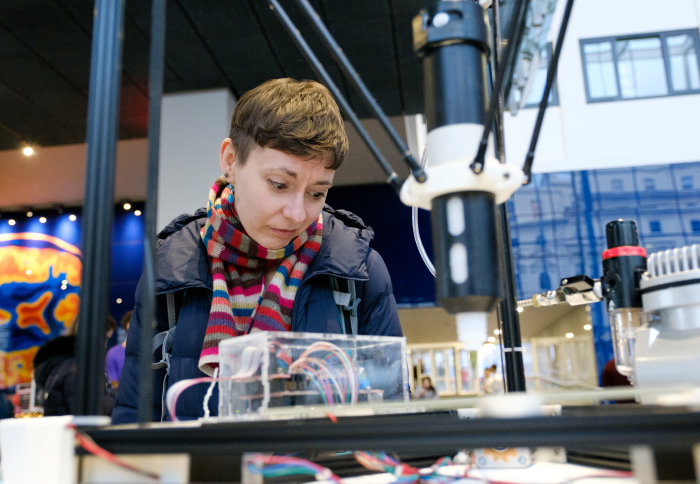

For the latest Imperial Fringe, visitors travelled through the history of Imperial inventions, right up to present-day innovations.
Imperial has a long history of daring inventions and discoveries, from the first synthetic dye to the development of the first antibiotic, penicillin. These past triumphs were on display at the Invention Dimension Fringe alongside brand new innovations from the Imperial College Advanced Hackspace, from a test for bacterial infections to affordable bionic arms.
Fleming’s microscope

The discovery of penicillin is one of science’s great stories, and the location of the discovery is now the Alexander Fleming Laboratory Museum at St. Mary’s Hospital, now part of Imperial.
Fleming biographer and curator of the museum, Kevin Brown, was on hand to show visitors a selection of items from the museum, all relating to the advent of the antibiotic age. Fleming’s microscope itself was there, along with Petri dishes containing penicillin.
Kodama World

Kodama is an amazing new way for kids to engage with technology, originally developed at Imperial. The device allows children to play games where they can explore and create in a 3D digital space.
The Kodama kit has a mat representing the virtual space, and a tracker that allows an in-game object or character to be moved. Antoni Pakowski, one of the cofounders of the product, explained that the Fringe offered a great opportunity to get people engaged, particularly in light of their soon-to-be launched Kickstarter campaign.
Clyq
If you’re bored of waiting in line for your lunch, Imperial students have got you covered. Matt Wells is a third-year PhD student working on Clyq, an app designed to get rid of queuing and get you your lunch quicker. He told us a bit more about the concept.
The idea is to order your food via an app which would then be ready for you to pick up upon arrival. The team are hoping to relieve some of the workload on catering staff, and allow people to explore new foods that perhaps they haven’t tried before.
Affordable bionic arms

Prosthetic limbs are surprisingly expensive, and often don’t cater to the needs of those who use them. A team at Imperial are tackling these concerns by creating affordable, lightweight prosthetic arms that can be adapted to specific requirements.
One of the students involved, Nate Macabuag, was at the Fringe to present the team’s work so far. He told us about how they had used Imperial resources, including the Advanced Hackspace, to develop their prototype products, which they are hoping to implement in the real world through their company, Mitt.
The Great Wave

Virtual reality (VR) explores the world in innovative ways, and Imperial alumna Bushra Burge is adding another level of interactivity through a new multi-sensory and immersive experience.
To tell stories of science, Bushra experiments with different materials and items that affect various senses. She has recently started using haptics (touch feedback) and VR in her work, which she brought along to trial at the Fringe. A hand-painted wearable garment moved on its own as members of the public put on a VR headset. This particular VR story explored our oceans, and the plastic issue threatening our seas.
QuickCount
It’s estimated that in Europe alone, antibiotic resistance kills 25,000 people a year, and this number is set to rise. Currently GPs have no definitive, quick method to distinguish between bacterial and viral infections, adding to the scale of the problem.
Through an Advanced Hackspace project, Mohit Devgan, a PhD student at Imperial, is trying to solve this and has created QuickCount. This is a quick, easy test which can efficiently decipher whether a patient is suffering from a bacterial infection by analysing a small blood sample. Mohit’s new test would only take one minute and cost £1, helping prevent the rise of antibiotic resistance.
Mauveine: the science behind the colour

It’s 180 years since the birth of chemist Sir William Henry Perkin, who studied at the Royal College of Chemistry, the first institution that would one day form part of Imperial. One of his most famous inventions was the synthetic dye mauveine, which he discovered at only 18 years old.
Saif Osmani, a visual artist and spatial designer, was celebrating this anniversary with an art station relating to Perkin’s work and mauveine. Visitors could look through inspiration from William Perkin’s archives, and create their own artworks, which were added to a central mauveine-coloured scroll.
Inventing history
 Anne Barrett is an Archivist at Imperial who took members of the public on a journey through Imperial’s past, displaying prototypes and artefacts from the College’s astounding 150-year collection.
Anne Barrett is an Archivist at Imperial who took members of the public on a journey through Imperial’s past, displaying prototypes and artefacts from the College’s astounding 150-year collection.
One of the items she brought along was old-fashioned holography, which had no purpose when it was first created, but is now used daily for bank cards and passports as a security method.
Her message was that any invention - even if the purpose isn’t seen at the time - will someday be useable when the technology to do something with it develops.
-
All photos (except holography) credit Owen Billcliffe.
Article text (excluding photos or graphics) © Imperial College London.
Photos and graphics subject to third party copyright used with permission or © Imperial College London.
Reporters

Rachel Kahn
Communications and Public Affairs

Contact details
Email: press.office@imperial.ac.uk
Show all stories by this author

Bridie Kennerley
Communications and Public Affairs

Contact details
Email: press.office@imperial.ac.uk
Show all stories by this author




Leave a comment
Your comment may be published, displaying your name as you provide it, unless you request otherwise. Your contact details will never be published.